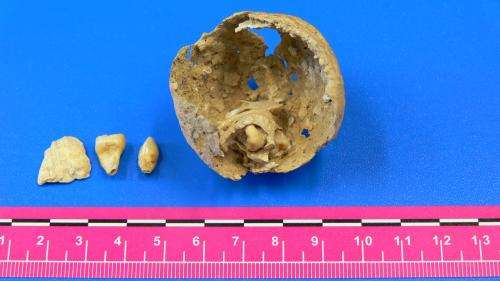Ovarian tumor, with teeth and a bone fragment inside, found in a Roman-age skeleton

A team of researchers led by the Universitat Autonoma de Barcelona in Spain has found the first ancient remains of a calcified ovarian teratoma, in the pelvis of the skeleton of a woman from the Roman era. The find confirms the presence in antiquity of this type of tumour - formed by the remains of tissues or organs, which are difficult to locate during the examination of ancient remains. Inside the small round mass, four teeth and a small piece of bone were found.
Teratomas are usually benign and contain remains of organic material, such as hair, teeth, bones and other tissues. There are no references in the literature to ovarian teratomas in ancient remains like those found in this study, led by the researcher Núria Armentano of the Biological Anthropology Unit of the UAB and published in the International Journal of Paleopathology.
The tumour in question is rounded in shape, with a wrinkled surface, of the same colour as the bones, about 43 mm long and 44 mm in diameter. It was found in the right-hand part of the pelvis of a woman of between 30 and 40 years of age and who lived around 1,600 years ago, and came from the Roman cemetery in the archaeological site of La Fogonussa (Lleida). A macroscopic examination and a scan revealed four teeth of anomalous morphology inside the tumour, two of which were adhering to the inside wall of the tumour, and a small bone fragment.
"The calcification and preservation of the external walls of this tumour are exceptional, since these types of remains usually only retain the internal structures and the extremely fragile external ones disappear", explains Assumpció Malgosa, co-author of the study.
In fact, there are very few differential diagnoses of pelvic and abdominal calcifications in archaeological contexts, among other reasons because it is so difficult to determine their nature - they could be kidney stones, fibromas, teratomas, arterial remains, etc. etc. Moreover, they are hard to spot during the excavation and can easily be mistaken for stones.
Teratomas are asymptomatic in 60% of cases, but on occasion they cause torsions and functional problems in nearby organs, by compression when they are large. Pregnancy seems to favour certain complications in teratomas, such as complications on giving birth. Nevertheless, nowadays they seldom grow large and calcify even less often, because they are detected and operated on very early.
In the case of the Roman woman the researchers do not discount the possibility that the tumour was the cause of death, though this cannot be certain. It is also possible that she lived all her life with the calcified tumour with no further complications.
The skeleton was recovered in 2010 during the excavation of 46 graves in La Fogonussa, and formed part of a total of 87 skeletons. It was complete and well-preserved, buried in a tile grave.
Provided by Universitat Autonoma de Barcelona
















